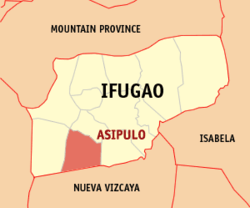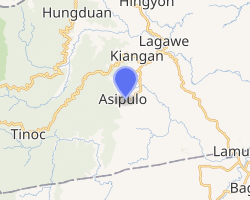Asipulo, Ifugao
Asipulo, officially the Municipality of Asipulo is a 5th class municipality in the province of Ifugao, Philippines. According to the 2015 census, it has a population of 15,261 people.[3]
Asipulo | |
|---|---|
| Municipality of Asipulo | |
 Seal | |
 Map of Ifugao with Asipulo highlighted | |
OpenStreetMap 
| |
.svg.png) Asipulo Location within the Philippines | |
| Coordinates: 16°43′15″N 121°04′10″E | |
| Country | |
| Region | Cordillera Administrative Region (CAR) |
| Province | Ifugao |
| District | Lone District |
| Barangays | 10 (see Barangays |
| Government | |
| • Type | Sangguniang Bayan |
| • Mayor | Armando P. Domilod |
| • Vice Mayor | Clarence P. Bahingawan |
| • Congressman | Solomon R. Chungalao |
| • Electorate | 7,625 voters (2019) |
| Area | |
| • Total | 182.87 km2 (70.61 sq mi) |
| Population (2015 census)[3] | |
| • Total | 15,261 |
| • Density | 83/km2 (220/sq mi) |
| • Households | 2,829 |
| Economy | |
| • Income class | 5th municipal income class |
| • Poverty incidence | 44.85% (2015)[4] |
| • Revenue (₱) | 66,395,339.34 (2016) |
| Time zone | UTC+8 (PST) |
| ZIP code | 3610 |
| PSGC | |
| IDD : area code | +63 (0)74 |
| Climate type | tropical rainforest climate |
| Native languages | Ifugao language Tuwali language Ilocano Tagalog |
| Website | www |
The town, formerly part of Kiangan, was incorporated as a separate municipality pursuant to Republic Act No. 7173, ratified on January 13, 1992.[5]
Barangays
Asipulo is politically subdivided into 10 barangays. [2]
- Amduntog
- Antipolo
- Camandag
- Cawayan
- Haliap
- Liwon
- Namal
- Nungawa
- Panubtuban
- Pula
Climate
| Climate data for Asipulo, Ifugao | |||||||||||||
|---|---|---|---|---|---|---|---|---|---|---|---|---|---|
| Month | Jan | Feb | Mar | Apr | May | Jun | Jul | Aug | Sep | Oct | Nov | Dec | Year |
| Average high °C (°F) | 23 (73) |
24 (75) |
26 (79) |
28 (82) |
27 (81) |
27 (81) |
26 (79) |
26 (79) |
26 (79) |
26 (79) |
25 (77) |
24 (75) |
26 (78) |
| Average low °C (°F) | 16 (61) |
17 (63) |
18 (64) |
20 (68) |
21 (70) |
21 (70) |
21 (70) |
21 (70) |
21 (70) |
19 (66) |
18 (64) |
17 (63) |
19 (67) |
| Average precipitation mm (inches) | 38 (1.5) |
57 (2.2) |
77 (3.0) |
141 (5.6) |
390 (15.4) |
355 (14.0) |
426 (16.8) |
441 (17.4) |
426 (16.8) |
259 (10.2) |
97 (3.8) |
57 (2.2) |
2,764 (108.9) |
| Average rainy days | 10.4 | 12.1 | 15.4 | 20.4 | 26.7 | 27.1 | 28.7 | 28.0 | 26.4 | 19.9 | 14.1 | 12.3 | 241.5 |
| Source: Meteoblue [6] | |||||||||||||
Demographics
| Year | Pop. | ±% p.a. |
|---|---|---|
| 1995 | 9,964 | — |
| 2000 | 12,294 | +4.61% |
| 2007 | 13,340 | +1.13% |
| 2015 | 15,261 | +1.70% |
| Source: Philippine Statistics Authority[3][7][8][9] | ||
In the 2015 census, the population of Asipulo was 15,261 people,[3] with a density of 83 inhabitants per square kilometre or 210 inhabitants per square mile.
JCampbell Park
The JCampbell Park or Julia Campbell Agroforest Memorial Eco-Park, is an eco-park located in Barangay Pula in this town. The camp is dedicated in memory of Julia Campbell (journalist), a U.S. Peace Corps volunteer working in the Philippines and was murdered in the area in 2007 on her trek to Batad Rice Terraces.
References
- "Municipality". Quezon City, Philippines: Department of the Interior and Local Government. Retrieved 31 May 2013.
- "Province: Ifugao". PSGC Interactive. Quezon City, Philippines: Philippine Statistics Authority. Retrieved 12 November 2016.
- Census of Population (2015). "Cordillera Administrative Region (CAR)". Total Population by Province, City, Municipality and Barangay. PSA. Retrieved 20 June 2016.
- "PSA releases the 2015 Municipal and City Level Poverty Estimates". Quezon City, Philippines. Retrieved 12 October 2019.
- "Republic Act No. 7173 - An Act Creating the Municipality of Asipulo in the Province of Ifugao". Chan Robles Virtual Law Library. 13 January 1992. Retrieved 28 January 2016.
- "Asipulo: Average Temperatures and Rainfall". Meteoblue. Retrieved 8 March 2020.
- Census of Population and Housing (2010). "Cordillera Administrative Region (CAR)". Total Population by Province, City, Municipality and Barangay. NSO. Retrieved 29 June 2016.
- Censuses of Population (1903–2007). "Cordillera Administrative Region (CAR)". Table 1. Population Enumerated in Various Censuses by Province/Highly Urbanized City: 1903 to 2007. NSO.
- "Province of Ifugao". Municipality Population Data. Local Water Utilities Administration Research Division. Retrieved 17 December 2016.
External links
- Asipulo Profile at PhilAtlas.com
- Philippine Standard Geographic Code
- Philippine Census Information
- Local Governance Performance Management System